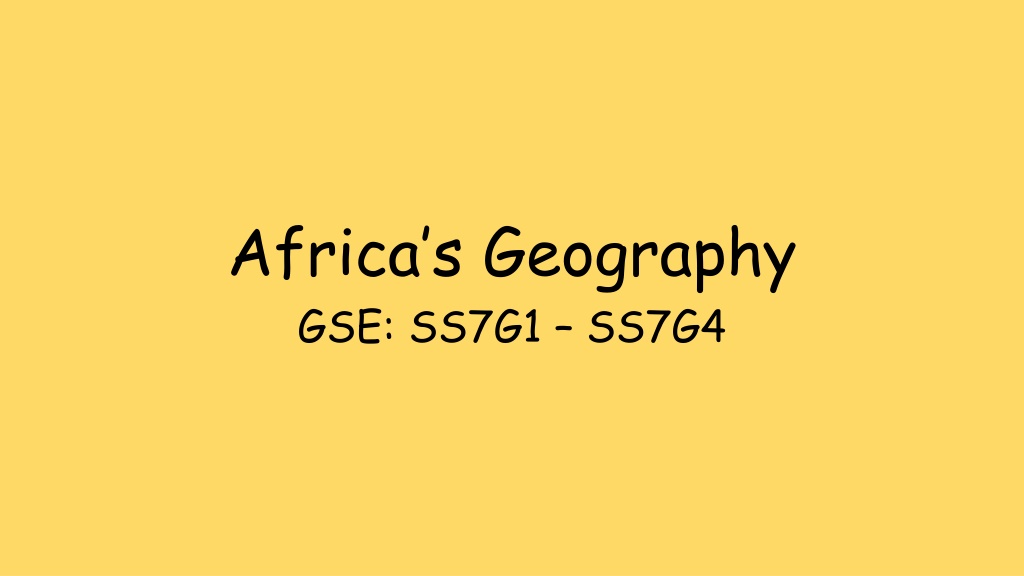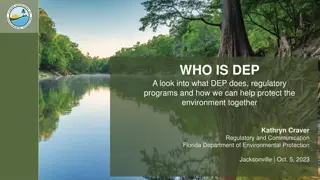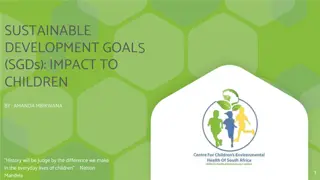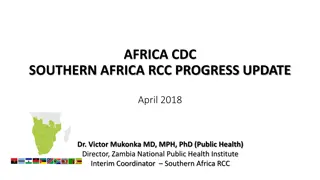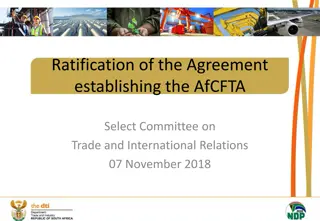Understanding Environmental Issues in Africa
Africa's geography and environmental challenges are explored in this content, covering key features like the Sahara, Sahel, savanna, rain forests, and rivers. The impact of water pollution, unequal access to water, deforestation, and desertification on Africa's environment is discussed, along with the continent's natural resources and their exploitation. This informative material sheds light on the importance of sustainable practices to preserve Africa's rich ecosystems.
Download Presentation

Please find below an Image/Link to download the presentation.
The content on the website is provided AS IS for your information and personal use only. It may not be sold, licensed, or shared on other websites without obtaining consent from the author. Download presentation by click this link. If you encounter any issues during the download, it is possible that the publisher has removed the file from their server.
E N D
Presentation Transcript
Africas Geography GSE: SS7G1 SS7G4
SS7G1 Locate selected features of Africa. a. Locate on a world and regional political-physical map: Sahara, Sahel, savanna, tropical rain forest, Congo River, Niger River, Nile River, Lake Victoria, Great Rift Valley, Mt. Kilimanjaro, Atlas Mountains, and Kalahari Desert. b. Locate on a world and regional political-physical map the countries of Democratic Republic of the Congo, Egypt, Kenya, Nigeria, South Africa, and Sudan. Egypt Sudan Great Rift Valley Nigeria Kenya Dem. Rep. of the Congo Mt. Kilimanjaro SouthAfrica
4 Vegetation Regions Desert - A desert is any large region that gets very little rain each year. Very few plants or animals live in desert areas. Sahara in the north and the Kalahari in the south are examples in Africa. Sahel - (from Arabic for shore or border) - is located to the south of the Sahara running from the Atlantic Ocean to the Horn of Africa. . It is a region of dry grassland. Rainfall varies greatly from year to year. Savanna - The savanna zone is located below the sahel. A large part of Africa is made up of savannas, which has good soil, thick grass, and scattered tall trees. This is where you find most of the animals associated with Africa. Although rainfall is generally seasonal, rivers are found in many savanna regions and often cause seasonal floods. Rain Forest - a forested area where the annual rainfall is high. Rainforests are primarily found in tropical climates, although there are some rainforests in temperate regions. Rainforests have been subjected to heavy logging and the area covered by rainforest around the world is shrinking rapidly.
SS7G2 Explain environmental issues across the continent of Africa. a. Explain how water pollution and unequal access to water impacts irrigation, trade, industry, and drinking water. b. Explain the relationship between poor soil and deforestation in Sub-Saharan Africa. c. Explain the impact of desertification on the environment of Africa.
Africas Environmental Issues Natural Resources Africa has a variety of natural resources. Kenya s fertile highlands are excellent for growing crops. Nigeria is the leading producer of oil in Africa. South Africa has many minerals including gold and diamonds. Deforestation Deforestation is taking place in countries such as C te d Ivoire and Kenya. The Tropical Rainforest along the equator is threatened as trees are cut down for commercial logging, to make room for expanding cities, and to clear land for farmland. The loss of forests threatens the habitats of many plants and animals. Desertification Desertification is a problem affecting the Sahel region of Africa as the Sahara Desert has been expanding southward into areas that had previously been fertile. Human activities such as overgrazing and deforestation contribute to desertification. Water Because much of North Africa is covered by the Sahara Desert, access to water is very important. Much of North Africa is uninhabited. Settlements are either along rivers or at oases at natural springs. The Nile River, which flows through Egypt and Sudan, is the primary source of water in East Africa and has influenced where people live
Droughts, or long periods of time with little rainfall, have hurt the Sahel, too. The people who live in these areas often face starvation and poverty. Many move into urban areas hoping to find work, but most find only poverty. Left: Irrigation systems allow farmers to get water to dry areas.
Deforestation is the destruction of trees and other vegetation. This continues to be a problem in the Sahel and elsewhere in Africa. Above: (Left) Aerial view of erosion in Madagascar due to deforestation; (Right) Illegal logging in Madagascar.
Desertification: Animals have been allowed to graze too heavily in an area and have stripped all of the vegetation from the soil. People who need fuel or who hope to clear new farmland have cut down the trees that help hold the soil in place. Above: (Left) Photo of felled emergent canopy tree in Gabon; (Right) Portions of the savanna burned for game hunting purposes
Review Questions: In sub-Saharan Africa, less than 50% of the population has access to safe drinking water because of environmental pollution How has this shortage of safe drinking water affected development in sub- Saharan Africa? A. Slowed economic growth. * B. Increased size of the Sahara. C. Increased population growth. D. Slowed the deforestation of the rain forest. What effect does poor soil and deforestation have on land in Africa? A. Land is excellent archeological dig sites. B. Land is useless for farming and agriculture.* C. Land becomes part of national park systems. D. Land becomes a better place to raise a family. In the Sahel, overgrazing and drought have resulted in a decrease in the grassland region. What is this process called? A. Deforestation B. Desertification* C. Unequal distribution D. Environmental pollution
SS7G3 Explain the impact of location, climate, and physical characteristics on population distribution in Africa. a. Explain how the characteristics in the Sahara, Sahel, savanna, and tropical rain forest impact trade and affect where people live. You ll get additional information about this standard from viewing four documentaries about life in Africa s vegetation regions. The PBS Africa series videos are: Desert Odyssey Savanna Homecoming Love in the Sahel Voices of the Forest
Review Question Explain why the population of the Sahara is low. A. Too much oil. B. Too much water. C. Limited access to oil. D. Limited access to water.*
SS7G4 Analyze the diverse cultural characteristics of the people who live in Africa. a. Explain the differences between an ethnic group and a religious b. b. Describe the diversity of religions within African ethnic groups.
Ethnic groups share many common characteristics, such as language, physical appearance, customs, and traditions. Religious groups share a common belief system, but are not necessarily composed of a single ethnic group. Ethnic groups and religious groups are not defined by political borders, but may be common to an region or country. Ex: Many people in North Africa are Arab and many Arabs practice the religion of Islam.
Religion in Africa Traditional religious beliefs are the native religions of Africa. They may include worship of ancestors, spirits, gods, animals, land, inanimate objects, and/or natural phenomena. In some cases these traditional beliefs are combined with Christianity. Ex: animism Islam and Christianity in modern Africa: Arab traders from the Middle East brought their religion, Islam to Africa in the late 600 s. Islam is practiced by almost half of all African. It is most common in North Africa, the Horn of Africa, the Swahili coast, and parts of West Africa. Christianity first appeared in Egypt in the 2nd century A.D. ,but became more widespread when missionaries from Europe and the Americas introduced Christianity in the 1800s to central and southern Africa. About 40% of Africans practice Christianity.
Ethnic Groups in Africa Africa has thousands (yes, 1,000s!) of ethnic groups across the continent. In addition to Arabs who commonly live in the north, there are others of note. Bantu and Swahili refer to both languages and ethnic groups. Bantu is the language and ethnic group from which the Swahili language and ethnic group developed. While the Swahili language is spoken by over 90 million people, the Swahili ethnic group numbers about 1.3 million. They primarily live in East African countries like Kenya and Tanzania. The primary religion practiced by the Swahili ethnic group is Islam. The Bantu migration, which spanned many centuries, influenced the development of many ethnic groups and languages in sub-Saharan Africa. It is estimated that as many as two- thirds of the people living in Africa today have roots in the Bantu language and ethnic group. Traditional beliefs, Islam, and Christianity are found among Bantu peoples. The Ashanti people of today live primarily in Ghana and number about 7 million. While the majority of Ashanti are Christian, traditional religious beliefs are the second largest religious group. The smallest percentage of Ashanti is Islamic. For the Ashanti their traditional beliefs are a mixture of spiritual and supernatural powers.
Review Questions Which person is a member of a religious group? A.Nemal is a Kurd. C. Kimba is an Ashanti. B. Mustafa is a Muslim.* D. Lakesha is a Nigerian. African religious beliefs include traditional religious beliefs that came before the introduction of Christianity and Islam to the continent. Which of these statements describes traditional African religious beliefs? A.Belief in Krishna. B. Belief their king is a god. C. Belief in the importance of a divine savior. D.Belief in the influence of ancestors of daily life.*
